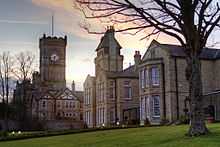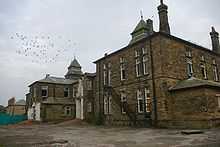High Royds Hospital


Coordinates: 53°52′54″N 1°44′05″W / 53.8818°N 1.7347°W
High Royds Hospital is a former psychiatric hospital south of the village of Menston, West Yorkshire, England.
The hospital is located within in the City of Leeds metropolitan borough and was first opened on 8 October 1888 as the West Riding Pauper Lunatic Asylum. The hospital closed in 2003 and the site has since been developed for residential use, some of which is in the old hospital buildings.
Design and construction
The hospital was designed on the broad arrow plan by architect J. Vickers Edwards. The 300 acre (1.2 km²) estate on which the asylum was built was purchased by the West Riding Justices for £18,000 in 1885 and the large gothic complex of stone buildings was formally opened on 8 October 1888.
The administration building, which is Grade II listed, features an Italian mosaic floor in the main corridor which is intricately decorated with the Yorkshire Rose and black daisies - the latter of which provided inspiration for the title of Black Daisies a television screenplay, filmed at High Royds, which took as its subject the experiences of sufferers of Alzheimers disease.
Facilities
The hospital was intended to be largely self-sufficient, and was provided with its own library, surgery, dispensary, butchery, dairies, bakery, shop, upholster's and cobbler's workshops and a large estate partly devoted to agriculture and market gardening. The patients lived in wards and if they were able, were expected to work towards their keep either on the farm, in the kitchens and laundry, or in various handicrafts. The hospital was formerly connected to the Wharfedale railway line by its own small railway system, the High Royds Hospital Railway, but this was closed in 1951.[1]
Decline and closure
In its final years of operation, High Royds had become outdated and unsuited to modern psychiatric practice. As part of Leeds Mental Health's £47 million reprovision process it was closed, with the wards being relocated to various community mental health units within the city of Leeds in the three years leading up to its closure. These include the Becklin Centre in St James' Hospital and the Mount in the city centre. The hospital was closed in stages between 25 February 2003 and June of the same year.
As of 2011, the site was being redeveloped as a new village, also called High Royds, retaining some features of the hospital such as the ballroom and the clock tower.
High Royds in popular culture
Since its closure, the site has been used as a film set for the film Asylum, as well as for the successful television series No Angels and Bodies.[2]
The drama Diamond Geezer starring David Jason which aired on ITV1 in March 2005 was also partly shot at High Royds.
Leeds band Kaiser Chiefs have written a song ("Highroyds") about the former hospital. Three of the band (Nick Hodgson, Nick 'Peanut' Baines and Simon Rix) used to attend St. Mary's Catholic High School, the school that faces High Royds Hospital.
The band Kasabian named their third album, West Ryder Pauper Lunatic Asylum [sic], after the hospital after hearing about it on a TV documentary.[3]
References
- ↑ The Railways of Wharfedale, Peter E. Baughan (1969) David & Charles (Publishers) Ltd
- ↑ "Martin Cook-Lights, Camera, Action". Retrieved 4 July 2014.
- ↑ "Sergio's track by track guide". Retrieved 4 July 2014.
External links
| Wikimedia Commons has media related to High Royds Hospital. |